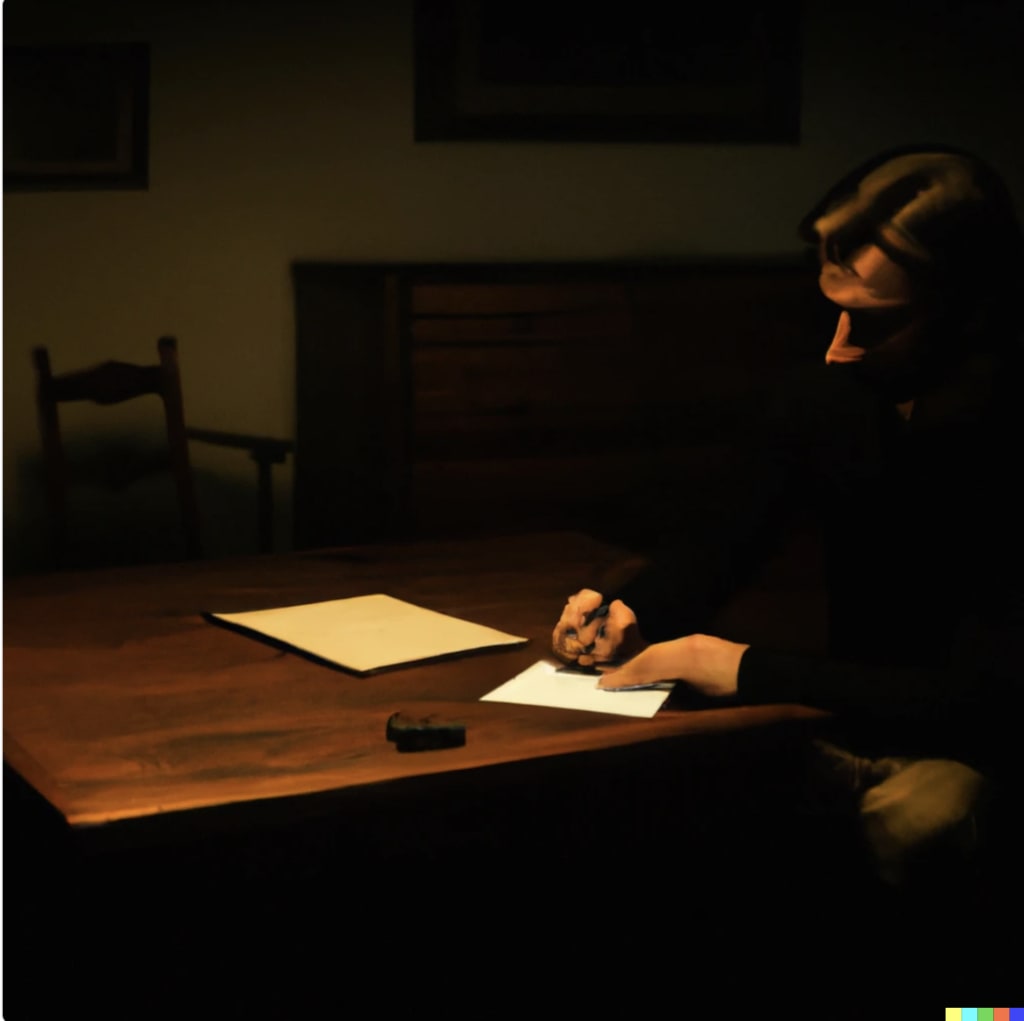On Showing and Telling
And why it’s complicated

I’m reasonably sure that even the meme about how everyone says "show don’t tell" is a meme. Naturally I’m just your average internet goblin so I'm hardly the definitive source. But what I am certain about is that this standard piece of advice isn’t worth the paper it's written on.
As with all things creative, this advice is decent in principle, but it seriously lacks in the application department. “Show don’t tell,” is shouted with such staggering frequency that most writers effectively have it tattooed on the inside of their skulls. If you don’t, then I suggest you get it there just to make sure you don’t forget.
Despite my above claim that it’s worthless, I’m going to be a hypocrite and equally claim that it is a very sound and valuable piece of advice. The difficulty is that the statement itself lacks direction, focus, and rules of application. Showing and telling are both essential parts of story telling, and have very different roles in prose.
Showing is important for evoking a scene, setting, or atmosphere. “The house was sad looking,” is a perfectly acceptable sentence, unless the writer really wants the reader to feel that sadness. Instead, the author might want to describe the broken windows and cracked stones of the driveway; or linger on how the door hangs from one rusted hinge, creaking back and forth in the wind. By doing that, the reader feels the sense of neglect that hangs around the house like smoke on a windless night.
Or, using the same example, the writer can focus on the feeling of abandonment. A deflated ball in the overgrown front yard, an overturned tricycle, and rusted bikes in the garage can do a lot to make the reader feel like the house has lost something; that it was once a place where a family lived, laughed, loved, etc. but now it’s a ruin of a place, slowly falling apart.
Telling, on the other hand, moves the story along nicely. Instead of describing how every step the detective takes echoes off the vynl wood paneling almost sounding like a second set of footsteps. “They went down the hall” takes the character from point A to point B quickly, allowing the reader to get to the next plot point faster.
Each has their function, and each must be in every story. Don’t believe me? I have examples.
First, in my short story “Did I Ever Tell You…” written for the Tall Tale Challenge
I almost exclusively tell the reader what is happening. Using the framing device of a grandfather telling a tall tale, I simply tell the reader a silly story about a talking walrus. (The story is of course completely true, and frankly I’m insulted you thought otherwise.)
But within it, I evoke certain things about the relationship between speaker and listener through actions. The grandfather teases his grandchild, inserts little jokes, and pretends to fall of his seat. In this way, I set him up as a man who likes to make the child laugh. At no point to do I say “he’s a funny man,” but I try to show it through what he says and does.
The narrative itself is almost completely conveyed by telling the reader exactly what is happening at any given moment. The grandfather wears his best hat, and has tea with a walrus who tells him how to get what he wants out of life. Simple, easy to follow, and breaking the golden rule so thoroughly that I’m expecting a visit from the writing police any day now.
Despite that, I show the reader what kind of a man/grandfather he is through what he does and how he tells his story. It would have fallen apart competely if I turned to the camera and said, “boy they’re having a good time. Have you noticed how he’s trying to make the kid laugh? Isn’t he a kindly sort?”
Now, the other end of the spectrum also exists. Stories that are more showing than telling, as the literature says that all good ones must be.
Take: “A Girl Who Sang the Blues,” (also by me)
I was trying to tell a noir detective story about a tragic loss of a loved one. Because it’s something of a twist ending, I won’t discuss the plot, but how I told the story is important. The detective does explain in plain English how he went about his quest, but it’s a secondary element to the atmosphere of the unnamed speakeasy and the emotions of the characters.
By trying to paint the scene with words, I did my best to put the reader at the table with Richard and Amelia. I wanted them to hear the music, smell the cigarette smoke, and taste the amazing cocktails. When Archie tells his story, the hope is that you feel the anxiety of both listeners, that you share the distrust of Amelia and the hopeless hopefulness of Richard.
The atmosphere is supposed to bleed off the page and make the reader feel everything as though it was happening to them instead of people I made up out of whole cloth. I invite you to tell me if I succeeded or not, but the attempt was made.
At the end, when there’s some catharsis, I wanted you to feel Archie’s regret, Amelia’s heartbroken relief in having answers, and Richard’s depressed closure. Foreboding, mystery, melancholy, all those lovely noir pieces of set dressing are what I wanted the reader to experience as you read that story.
The crushing sadness and grief and loss are supposed to climb off the page and sit next to you as you read. But again, I tell certain things in this story. Mostly, what I tell falls to actions: I outright say that Amelia dislikes and distrusts Archie, I state that Richard lays a hand on Amelia’s arm, and of course through Archie I simply tell the whole of his investigation.
These things are part of the framing device that help to support the evocation of the place and the feelings. Without them, I could have rattled away about how the scene and atmosphere.
Most fiction, though, does not put the emphasis on either showing or telling. It tries to find a happy medium through which the story is best presented. Though, typically the share of showing is larger because that is what really grounds the reader in the narrative and helps to keep them turning the pages.
Just one more example, I promise. This one comes from my piece “The Call of the Void”
In this story I did my best to put everything together. I told the reader enough to move the plot, and I evoked (showed) the empty space station and Hector’s degrading mind. Several times, I straight up said that he was alone and that a lot of people lose it when they’re isolated like that, but then I demonstrated how the isolation was affecting or could affect him.
Through his actions, I displayed how handy he is and how important the act of fixing things is to him. His love for his garden and the task of reassembling the fan jump up and say ‘howdy’ without me ever whispering in your ear that he really likes doing things with his hands.
His fear of losing his mind, and his resourcefulness are shown plain as day through his actions. Other elements of who Hector is and how he lives are stated outright. He got bored with lavish clothes because they were impractical. He remembers the taste of real coffee. He programmed himself a therapy robot. He avoids over consumption of alcohol.
Each element, each instance of showing or telling was specifically chosen to create a particular piece of the story. To evoke the lonliness of the setting or to express a part of his character, to explain what he was doing and why, I needed to be judicious in which of the two I used. I think I succeeded, but you tell me.
So, long story short, ‘show don’t tell’ is a very useful adage. People generally should show more than they tell, but it has to be taken with a pinch of salt. Experiment, try showing a scene and try telling it, determine one by one which you should use. They’re both equally valid and valuable, and both equally critical to crafting your best work.
-0-0-0-0-0-0-0-
Please go ahead and let me know what you think down below :)
The Great Courses on audible has a fantastic lecture series called “Writing Great Fiction: Storytelling Tips and Techniques” that touches on this theme in one of their episodes. I’m not involved with Them at all but loved the series so figured I’d share it with you.
And if you liked this essay of mine, I invite you to check out why inspiration and I are mortal enemies in “On Inspiration: and why it’s bull****” https://vocal.media/journal/on-inspiration
About the Creator
Alexander McEvoy
Writing has been a hobby of mine for years, so I'm just thrilled to be here! As for me, I love writing, dogs, and travel (only 1 continent left! Australia-.-)
I hope you enjoy what you read and I can't wait to see your creations :)
Reader insights
Outstanding
Excellent work. Looking forward to reading more!
Top insights
Expert insights and opinions
Arguments were carefully researched and presented
Eye opening
Niche topic & fresh perspectives






Comments (2)
Yes yes, I like it. Way to think outside the box: great food for though for writers.
So true, telling is important, too... it's knowing when to use which that is the trick 😁